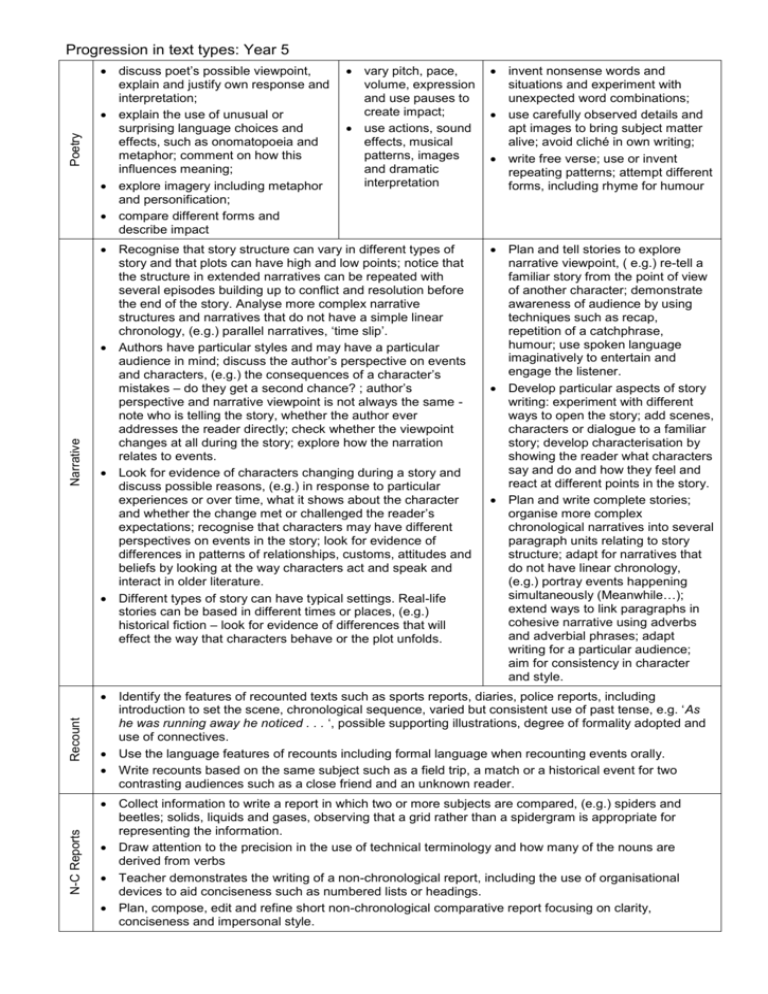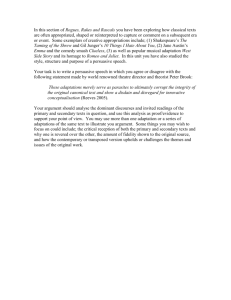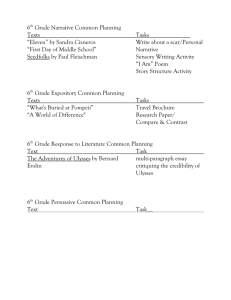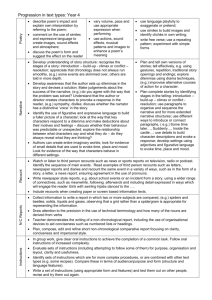Year 5
advertisement

vary pitch, pace, volume, expression and use pauses to create impact; use actions, sound effects, musical patterns, images and dramatic interpretation invent nonsense words and situations and experiment with unexpected word combinations; use carefully observed details and apt images to bring subject matter alive; avoid cliché in own writing; write free verse; use or invent repeating patterns; attempt different forms, including rhyme for humour Recognise that story structure can vary in different types of story and that plots can have high and low points; notice that the structure in extended narratives can be repeated with several episodes building up to conflict and resolution before the end of the story. Analyse more complex narrative structures and narratives that do not have a simple linear chronology, (e.g.) parallel narratives, ‘time slip’. Authors have particular styles and may have a particular audience in mind; discuss the author’s perspective on events and characters, (e.g.) the consequences of a character’s mistakes – do they get a second chance? ; author’s perspective and narrative viewpoint is not always the same note who is telling the story, whether the author ever addresses the reader directly; check whether the viewpoint changes at all during the story; explore how the narration relates to events. Look for evidence of characters changing during a story and discuss possible reasons, (e.g.) in response to particular experiences or over time, what it shows about the character and whether the change met or challenged the reader’s expectations; recognise that characters may have different perspectives on events in the story; look for evidence of differences in patterns of relationships, customs, attitudes and beliefs by looking at the way characters act and speak and interact in older literature. Different types of story can have typical settings. Real-life stories can be based in different times or places, (e.g.) historical fiction – look for evidence of differences that will effect the way that characters behave or the plot unfolds. Plan and tell stories to explore narrative viewpoint, ( e.g.) re-tell a familiar story from the point of view of another character; demonstrate awareness of audience by using techniques such as recap, repetition of a catchphrase, humour; use spoken language imaginatively to entertain and engage the listener. Develop particular aspects of story writing: experiment with different ways to open the story; add scenes, characters or dialogue to a familiar story; develop characterisation by showing the reader what characters say and do and how they feel and react at different points in the story. Plan and write complete stories; organise more complex chronological narratives into several paragraph units relating to story structure; adapt for narratives that do not have linear chronology, (e.g.) portray events happening simultaneously (Meanwhile…); extend ways to link paragraphs in cohesive narrative using adverbs and adverbial phrases; adapt writing for a particular audience; aim for consistency in character and style. Recount discuss poet’s possible viewpoint, explain and justify own response and interpretation; explain the use of unusual or surprising language choices and effects, such as onomatopoeia and metaphor; comment on how this influences meaning; explore imagery including metaphor and personification; compare different forms and describe impact Identify the features of recounted texts such as sports reports, diaries, police reports, including introduction to set the scene, chronological sequence, varied but consistent use of past tense, e.g. ‘As he was running away he noticed . . . ‘, possible supporting illustrations, degree of formality adopted and use of connectives. Use the language features of recounts including formal language when recounting events orally. Write recounts based on the same subject such as a field trip, a match or a historical event for two contrasting audiences such as a close friend and an unknown reader. N-C Reports Narrative Poetry Progression in text types: Year 5 Collect information to write a report in which two or more subjects are compared, (e.g.) spiders and beetles; solids, liquids and gases, observing that a grid rather than a spidergram is appropriate for representing the information. Draw attention to the precision in the use of technical terminology and how many of the nouns are derived from verbs Teacher demonstrates the writing of a non-chronological report, including the use of organisational devices to aid conciseness such as numbered lists or headings. Plan, compose, edit and refine short non-chronological comparative report focusing on clarity, conciseness and impersonal style. Instructions In group work, give clear oral instructions to achieve the completion of a common task. Follow oral instructions of increased complexity. Evaluate sets of instructions (including attempting to follow some of them) for purpose, organisation and layout, clarity and usefulness. Identify sets of instructions which are for more complex procedures, or are combined with other text types (e.g. some recipes). Compare these in terms of audience/purpose and form (structure and language features). Write a set of instructions (using appropriate form and features) and test them out on other people; revise and try them out again. Information Routinely prepare for factual research by reviewing what is known, what is needed, what is available and where one might search. Use dictionaries and other alphabetically ordered texts efficiently. Appraise potentially useful texts quickly and effectively. Evaluate texts critically by comparing how different sources treat the same information. Begin to look for clues that indicate the reliability of a factual source. Locate information in a text in print or on screen confidently and efficiently through using contents, indexes, sections, headings +IT equivalent; skimming to gain overall sense of text; scanning to locate specific information; close reading to aid understanding. Sift through passages for relevant information and present ideas in note form that are effectively grouped and linked. Use simple abbreviations while note taking. Understand what is meant by ‘in your own words’ and when it is appropriate to copy, quote and adapt. Make notes for different purposes, e.g. noting key points as a record of what has been read, listing cues for a talk. Convert personal notes into notes for others to read, paying attention to appropriateness of style, vocabulary and presentation. Create plans for information texts drawing on knowledge of text types to decide form and style for different elements. Create an information text with a variety of elements, e.g. labelled explanatory diagram, reporting chart, recount. Create multi-layered texts, including use of hyperlinks, linked web pages Record and acknowledge sources in own writing. Summarise a passage, chapter or text in a specific number of words. Read a passage and retell it “in your own words” Explanation Progression in text types: Year 5 Read and analyse a range of explanatory texts, investigating and noting features of impersonal style: complex sentences; use of passive voice; technical vocabulary; use of words/phrases to make sequential, causal or logical connections. Engage in teacher demonstration of how to research and plan a page for a reference book on one aspect of a class topic using shared note-making and writing of the page, using an impersonal style, hypothetical language (if...then, might, when the...) and causal and temporal connections (e.g. while, during, after, because, as a result, due to, only when, so) as appropriate. In shared writing and independently, plan, compose, edit and refine explanatory texts, using reading as a source, focusing on clarity, conciseness and impersonal style. Persuasion Read and evaluate letters, e.g. from newspapers or magazines, intended to inform, protest, complain, persuade, considering (i) how they are set out, and (ii) how language is used, e.g. to gain attention, respect, manipulate Read other examples ( e.g. newspaper comment, headlines, adverts, fliers) to compare writing which informs and persuades, considering for example the deliberate use of ambiguity, half-truth, bias; how opinion can be disguised to seem like fact Select and evaluate a range of texts, in print and other media, on paper and on screen, for persuasiveness, clarity, quality of information From reading, to collect and investigate use of persuasive devices such as words and phrases, e.g. ‘surely’; persuasive definitions, e.g. ‘only a complete idiot…’, ‘every right-thinking person would…’; rhetorical questions, e.g. ‘are we expected to…?’; pandering, condescension, concession, e.g. ‘Naturally, it takes time for local residents…’; deliberate ambiguities, e.g. ‘probably the best…’; Draft and write individual, group or class persuasive letters for real purposes, e.g. put a point of view, comment on an emotive issue, protest; edit and present to finished state Write a commentary on an issue on paper or screen (e.g. as a news editorial or leaflet), setting out and justifying a personal view; use structures from reading to set out and link points, e.g. numbered lists, bullet points Construct an argument in note form or full text to persuade others of a point of view and: present the case to the class or a group; use Standard English appropriately; evaluate its effectiveness. Explore how ICT or other use of multimodality might support this. (e.g. develop a PowerPoint presentation.) Understand how persuasive writing can be adapted for different audiences and purposes, e.g. by using formal language where appropriate, and how it can be incorporated into or combined with other text types. Discussion Progression in text types: Year 5 In exploring persuasive texts, and those presenting a particular argument (see above), distinguish and discuss any texts which seems to be trying to present a more balanced or reasoned view, or which explore more than one possible perspective on an issue. Experiment with the presentation of various views (own and others, biased and balanced) through discussion, debate and drama. Suggested Units for Year 5 NB The timing and ordering of these units can be flexible in order to create purposeful cross-curricular links. Narrative, plays and scripts 19-20 weeks Non-fiction 12-14 weeks UNIT 1 Novels and stories by significant children's authors * (4 weeks) UNIT 1 Instructions * (3 weeks) UNIT 2 Traditional stories, fables, myths, legends * (4 weeks) UNIT 3 Stories from other cultures (3 weeks) UNIT 2 Recounts on the Medium Term Planning (MTP) * (4-5 weeks) Poetry 5 weeks UNIT 1 Poetic style (word-play, rhyme, metaphor, word choice) (2 weeks) Additional text-based units There’s a Boy in the Girls’ Bathroom* (3 weeks) The Midnight Fox* (3 weeks) UNIT 4 Older literature (3 weeks) UNIT 5 UNIT 6 Film Dramatic narrative * conventions * (3 weeks) (2-3 weeks) UNIT 3 Persuasive writing (5-6 weeks) UNIT 2 Classic/narrative poems * (2 weeks) Street Child* (3 weeks) Y5/6 TRANSITION UNIT Persuasion* (3 weeks in Y5) UNIT 3 Choral and performance (1 week) The Highwayman* (3 weeks) Sensational!* (3 weeks) *The asterisk indicates units where there is detailed planning exemplification on the Primary Framework website, http://www.standards.dfes.gov.uk/primaryframework/literacy/planning/Year5/








